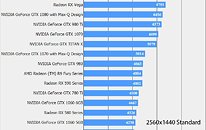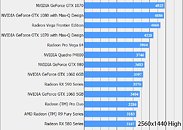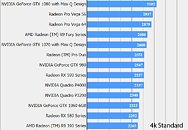Tuesday, October 30th 2018

AMD Radeon RX 590 Built on 12nm FinFET Process, Benchmarked in Final Fantasy XV
Thanks to some photographs by Andreas Schilling, of HardwareLuxx, it is now confirmed that AMD's Radeon RX 590 will make use of the 12 nm FinFET process. The change from 14 nm to 12 nm FinFET for the RX 590 brings with it the possibility of both higher clock speeds and better power efficiency. That said, considering it is based on the same Polaris architecture used in the Radeon RX 580 and 570, it remains to be seen how it will impact AMDs pricing in regards to the product stack. Will there be a price drop to compensate, or will the RX 590 be more expensive? Since AMD has already made things confusing enough with its cut down 2048SP version of RX 580 in China, anything goes at this point.Thanks to the Final Fantasy XV Benchmark being updated with results for the RX 590, we at least have an idea as to the performance on offer. In the 2560x1440 resolution tests, performance has improved by roughly 10% compared to the RX 580. Looking at the 3840x2160 resolution results shows a performance improvement of roughly 10 to 15%. This uplift in performance allows the RX 590 to put some serious pressure on NVIDIA's GeForce GTX 1060 6 GB. Keep in mind that while the RX 580 was always close, AMD's latest Polaris offering eliminates the gap and is far more competitive in a title that has always favored its competition, at least when it comes to comparing reference cards.When manual overclocking is taken into account, AMD's RX 580 can typically see a performance increase of around 5 to 10%. While this is speculation, in theory, it would put it on par or very near the RX 590 in terms of performance. However, no overclock is guaranteed so keeping that in mind, the move to the 12 nm FinFET process delivers a guaranteed performance boost with the possibility of further overclocking headroom. This should allow the RX 590 to further increase its performance advantage over the RX 580 and 570. Only time will tell how things shake out, but at the very least users can expect the AMD Radeon RX 590 to deliver on average 10% more performance over the current crop of RX 580 graphics cards.
Sources:
Twitter, FFXV Benchmark, via Videocardz








70 Comments on AMD Radeon RX 590 Built on 12nm FinFET Process, Benchmarked in Final Fantasy XV
I've got no problem with the RX 590 name, I think it fits actually.
A 590, slightly faster then a 580 for a slightly higher price, isnt going to attract anybody. The 480/580 have already saturated AMD's fans, the general market has long moved to nvidia because AMD didnt bother competing with nvidia for two generations in a row. The 590 wont offer anything to 580/480 owners. owners of first gen 7000 series cards may see a benefit, but they likely already moved onto a 480/580, vega, or nvidia chipset.
You all seriously believe literally everyone out there already bought a 480/580/1060 and no one else wants them ? May I also remind you how for a fairly big period of time , those cards were almost impossible to find or buy at sensible prices due to mining ? You all need to seriously rethink how this stuff works. If what you are saying is true then both AMD and Nvidia would register massive drops in GPU sales a few months after the launch of each new generation until the next one because everyone would have upgraded by then and no one would touch any card from that point on. Clearly that doesn't happen, these companies sell GPUs consistently throughout their lifespan, aimed at the same price bracket.
The point isn't that the 590 will definitely sell in droves but rather that all of them will keep selling until a true generational jump comes.
Don't take anything out of it. You can see the RX590 jumping all over the place versus a 1060 6GB depending on res and quality. Its retarded. Realistically you can expect this card to land between the 1060 6G and the 1070 stock. I reckon about square in the middle.
At this price/performance bracket, the 590 is offering the same thing AMD has been offering for FOUR YEARS now.Hey, genius, where is your evidence that people couldnt get their hands on these cards? The 480/580 and 470/570 sold quite well against nvidia initially. AMD and nvidia doesnt see these drops "a few months after launch" because you cant saturate the market after 3 months. You CAN saturate the market over the course of several years, which is what AMD has done. The 590 is an interesting offer for gamers still using old 7800 or 7700 series cards. Go look at steam's hardware survey, that is a TINY number of users compared to 480/580 owners or, god forbid, pascal users.
You seem to think that mid range buyers never bought 480s or 580s. While mining did jack prices up, there were plenty available at launch prices for months beforehand, and the used market has been a good source of below MSRP 480s for some time now. The price bracket also hosted hawaii for some time, which offered 480 performance at 480 prices for many months after the first mining crash. You have had 480 level performance for 4 years in this segment, and for some reason you think there is this huge group of PC gamers that STILL havent upgraded, but will open their wallets up for a minor 580 revision because ???
News flash, the people in the $200-300 bracket do not upgrade for minor performance increases, they only buy for massive gains in the same bracket, like 7850-480 level. Those people have had ample time to grab cards, and if steam is anything to go by, many have already upgraded. The 590 will not appeal to them, it will appeal to remaining 7800-7700 series users, which make up a small minority of AMD users today.
On the other hand, even Nvidia is still serving their midrange with a 2 year old offering called the 1060, and are even still producing tweaked versions of it.
Oddly convenient. Funny, even though you essentially admitted people are in fact still buying video cards in the same segment even years after the initial release you still don't want to give up your baffling argument that somehow the 590 will be an exception.
It's comparable to Intel's 14/14+/14++ nm.
That's how this card should be marketed with product appraisals of such set-ups, showing it can offer immersive and quality visuals. With the now profusion of panels that are $250-350, this would go after the vast market of 1080p gamers. My son just upgraded to a 2700X, but has been stuck at a 280X because he got behind the mining wagon. Now he's one wanting to move up to 1440p but doesn't like having to pay $350+ for a GPU that provides that.
Face it AMD isn't paying more for chips on the 12nm FinFET (heck I'd might say less). AIB's can for all intents and purpose reuse exist PCB's. Figure top-self memory chips might add 15% to cost of the ram chips which 8Gb now-a-days is like $35-40 cost. If all that is factual the cost to manufacture is hardly impacted.
It also means we're probably not going to be seeing a Vega 48 or Vega 32 as discreet cards. They're choosing to upgrade Polaris over cutting down Vega.